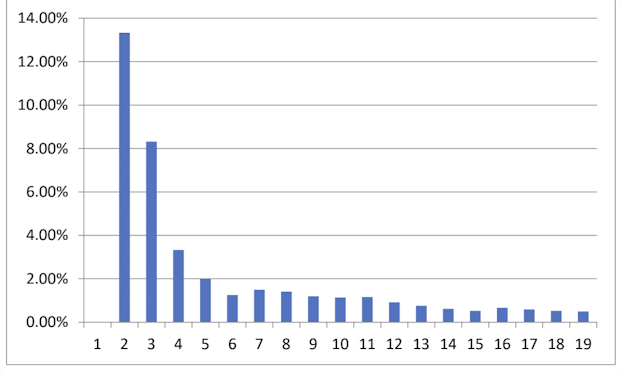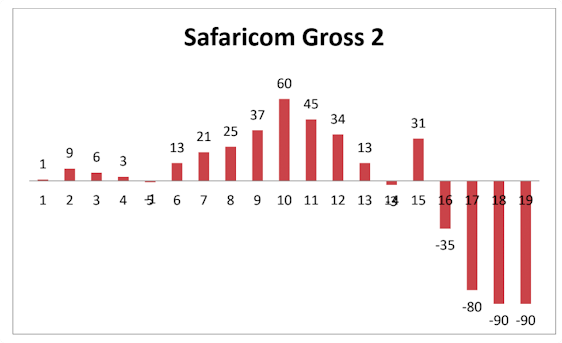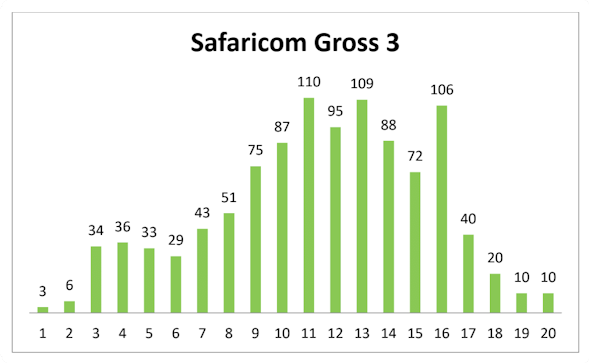The Mathematics of M-PESA 101
Welcome and in this blog we take look at M-PESA commission
tables and try and see what they tell us about the M-PESA service.
The analysis is based on 2012 Mpesa transaction Fees – the insights were very telling then and inform the design of mobile money economics today.
For my foreign readers, and they are the most, am sorry the
figures in the following tables are in Kenya Shillings, you are welcome to
convert them (using 1USD = 85KES), although not necessary in understanding and
following the discussion.
What is M-PESA
M-PESA is electronic mobile money issued by Kenyan MNO,
Safaricom Limited. The “M” = Mobile, and the PESA = Money is Swahili language.
M-PESA users buy the e-value by exchanging cash for e-value
at agents (merchants) outlets, this transaction called a deposit is offered
free of charge to M-PESA users at agents outlets.
Hence M-PESA users load e-value called Mpesa into their
phones, the Mpesa is the money offered by the M-PESA service.
SMS notifications act as alerts for confirmation of user’s
actions;
- · Withdrawals, exchanging Mpesa for cash.
- · Transfers, of Mpesa to other registered users and nonregistered users
- · Deposits, putting Mpesa into a mobile phone wallet.
- · Purchases, C2B transfers for payments of services.
M-PESA Customer Charges.
|
Customer Charges
|
|||||||||
|
Transaction Range (KShs)
|
Transaction Type and Customer
Charge (KShs)
|
Percentage of Customer Transaction Paid as Commissions
|
|||||||
|
Transaction Band
|
Min
|
Max
|
Transfer to other
|
Transfer to
Unregistered Users
|
Withdrawal from
|
Analysis
|
|||
|
M-PESA Users
|
M-PESA Agent
|
Mean of Transaction
Range
|
Send To M-PESA Users
|
Send To Unregistered
Users
|
Withdrawal From M-PESA
Agents
|
||||
|
1
|
10
|
49
|
3
|
N/A
|
N/A
|
29.5
|
10.17%
|
N/A
|
N/A
|
|
2
|
50
|
100
|
5
|
N/A
|
10
|
75
|
6.67%
|
N/A
|
13.33%
|
|
3
|
101
|
500
|
25
|
60
|
25
|
300.5
|
8.32%
|
19.97%
|
8.32%
|
|
4
|
501
|
1,000
|
30
|
60
|
25
|
750.5
|
4.00%
|
7.99%
|
3.33%
|
|
5
|
1,001
|
1,500
|
30
|
60
|
25
|
1250.5
|
2.40%
|
4.80%
|
2.00%
|
|
6
|
1,501
|
2,500
|
30
|
60
|
25
|
2000.5
|
1.50%
|
3.00%
|
1.25%
|
|
7
|
2,501
|
3,500
|
30
|
80
|
45
|
3000.5
|
1.00%
|
2.67%
|
1.50%
|
|
8
|
3,501
|
5,000
|
30
|
95
|
60
|
4250.5
|
0.71%
|
2.24%
|
1.41%
|
|
9
|
5,001
|
7,500
|
50
|
130
|
75
|
6250.5
|
0.80%
|
2.08%
|
1.20%
|
|
10
|
7,501
|
10,000
|
50
|
155
|
100
|
8750.5
|
0.57%
|
1.77%
|
1.14%
|
|
11
|
10,001
|
15,000
|
50
|
200
|
145
|
12500.5
|
0.40%
|
1.60%
|
1.16%
|
|
12
|
15,001
|
20,000
|
50
|
215
|
160
|
17500.5
|
0.29%
|
1.23%
|
0.91%
|
|
13
|
20,001
|
25,000
|
75
|
250
|
170
|
22500.5
|
0.33%
|
1.11%
|
0.76%
|
|
14
|
25,001
|
30,000
|
75
|
250
|
170
|
27500.5
|
0.27%
|
0.91%
|
0.62%
|
|
15
|
30,001
|
35,000
|
75
|
250
|
170
|
32500.5
|
0.23%
|
0.77%
|
0.52%
|
|
16
|
35,001
|
40,000
|
75
|
N/A
|
250
|
37500.5
|
0.20%
|
N/A
|
0.67%
|
|
17
|
40,001
|
45,000
|
75
|
N/A
|
250
|
42500.5
|
0.18%
|
N/A
|
0.59%
|
|
18
|
45,001
|
50,000
|
100
|
N/A
|
250
|
47500.5
|
0.21%
|
N/A
|
0.53%
|
|
19
|
50,001
|
70,000
|
100
|
N/A
|
300
|
60000.5
|
0.17%
|
N/A
|
0.50%
|
Table 1: Mpesa
End User Charges
Observations and Comments
The Transaction Bands
Current M-PESA (June 2012) has 12 charge bands corresponding
to different amounts that an M-PESA user can transact, ranging from KES 10.00
to KES 70,000.00
Transaction bands 1 could as well start at minimum value KES
1.00 and end at maximum value KES 50.00, then band 2 at KES 51.00 and end at
100.00, that way uniformity down the bands could have been maintained. These
two bands are the latest addition to Mpesa transaction bands.
The Spacing of the bands is very instructive in getting an
indicator where the most transactions are prevalent; between KES 10 and KES
10,000 there are ten transaction bands, while between KES 10,000 to KES 70,000
nine bands. Ordinary M-PESA users transact over 95% of their transactions below
KES 5,000.
What Can You Do With M-PESA
Once an M-PESA user has Mpesa (e-float acquired via a
deposit operations) in their phones they can do the following;
- · Transfer e-float (Mpesa) to other M-PESA users.
- · Transfer e-float to other non-registered users.
- · Withdraw e-float; convert to cash
Other uses of M-PESA not covered in table 1 above are:
- · ATM withdrawals, the withdrawals in table 1 are at an agent’s outlet.
- · Pay bill transactions, this are C2B transfers, and are commonly used for utility payments, subscription services, school fees.
- · Buy Goods transactions; also a C2B transfer at payment counters in restaurants, bars, supermarkets.
- · Buy Airtime, for your phone or somebody’s else phone
Analysis of Customer Charges
To simplify the analysis, the mean of the transaction band
is used, (min+max)/2.
Based on this the following three graphs derived to depict
what an M-PESA user is charged as a percentage of the value of the transaction.
Graph 1: Mpesa Transfers to Other M-PESA Users
The first three bars are packed with information and
interpretations.
Band 1, the first bar, KES 10-49, first this value cannot be
withdrawn at an M-PESA agent, secondly if I were sending it to you to buy
airtime top up, we are both better off if I just bought for you through my
phone.
Hence the only situation I would be sending you that value
(between 10-49) must be in a situation where you needed a top up of your
e-float so as to enable you to carry out another M-PESA transaction like a
withdrawal, and so in a monetary emergency.
Safaricom could also be envisaging a situation where small
merchants, who cannot register to get M-PESA business accounts could be
receiving Mpesa transfers from M-PESA users as payment for services, actually
very feasible taking cognizant of the many, varied and unintended (by design)
uses Mpesa is used for.
M-PESA transfer volumes are highest between transfer band 3
and 7 (KES 101 - KES3, 000).
Graph 2: Mpesa Transfers to Non-registered M-PESA Users
Note that transfers between KES 10 and KES 100, band 1 and
2, and those above KES 35,000, band 16, 17, 18 and 19, are not allowed.
The whole structure of the commissions is to deter sending
money to nonregistered users.
This in effect turns the registered M-PESA users into product
champions, extolling the benefits of registering on M-PESA to their relatives
and friends that they send money too.
Graph 3: Withdrawal From M-PESA Agents
The bars in this particular graph show a beautiful motion
dumping curve and further dove tails in an earlier observation (20,000
beautiful ones) that Tier-3 M-PESA agents are always ready to transact higher
withdrawal services than deposit service.
But that is not even the beauty of it, this curve is
business analytics and strategy applied to the max.
One, withdraws of KES 10 to KES 49, band 1 are not allowed.
Two, withdraws of 50 to 100, band 2 are punished, hence if
it is airtime, better buy it from the M-PESA menu, thereby driving, encouraging
and showing it is safe to carry out mobile commerce.
Three, the highest volumes of withdrawals occur in band 3,
KES 101 to KES 500 and this is the same for the other two types of transactions
above; transfers to registered and nonregistered users.
M-PESA agents’ commissions tariff structure next.
M-PESA Agents Commissions.
|
Agent Commissions for Withdrawal
Transactions
|
Percentage
of Transaction Value Received As Commission
|
|||||||
|
Transaction Bands (KShs)
|
(Registered Customers)
|
(Unregistered Customers)
|
Deposit Registered
Users Only
|
Mean of Transaction
Range
|
Withdrawal
Users
|
Withdrawal
None Users
|
Deposit
Users Only
|
|
|
10
|
49
|
N/A
|
N/A
|
N/A
|
29.5
|
N/A
|
N/A
|
N/A
|
|
50
|
100
|
5
|
N/A
|
4
|
75
|
6.67%
|
N/A
|
5.33%
|
|
101
|
500
|
8
|
8
|
8
|
300.5
|
2.66%
|
2.66%
|
2.66%
|
|
501
|
1,000
|
10
|
10
|
9
|
750.5
|
1.33%
|
1.33%
|
1.20%
|
|
1,001
|
1,500
|
12
|
12
|
10
|
1250.5
|
0.96%
|
0.96%
|
0.80%
|
|
1,501
|
2,500
|
15
|
15
|
11
|
2000.5
|
0.75%
|
0.75%
|
0.55%
|
|
2,501
|
3,500
|
20
|
20
|
12
|
3000.5
|
0.67%
|
0.67%
|
0.40%
|
|
3,501
|
5,000
|
25
|
25
|
14
|
4250.5
|
0.59%
|
0.59%
|
0.33%
|
|
5,001
|
7,500
|
30
|
30
|
20
|
6250.5
|
0.48%
|
0.48%
|
0.32%
|
|
7,501
|
10,000
|
35
|
35
|
28
|
8750.5
|
0.40%
|
0.40%
|
0.32%
|
|
10,001
|
15,000
|
45
|
45
|
40
|
12500.5
|
0.36%
|
0.36%
|
0.32%
|
|
15,001
|
20,000
|
60
|
60
|
55
|
17500.5
|
0.34%
|
0.34%
|
0.31%
|
|
20,001
|
25,000
|
65
|
65
|
71
|
22500.5
|
0.29%
|
0.29%
|
0.32%
|
|
25,001
|
30,000
|
70
|
70
|
87
|
27500.5
|
0.25%
|
0.25%
|
0.32%
|
|
30,001
|
35,000
|
70
|
70
|
103
|
32500.5
|
0.22%
|
0.22%
|
0.32%
|
|
35,001
|
40,000
|
100
|
N/A
|
119
|
37500.5
|
0.27%
|
N/A
|
0.32%
|
|
40,001
|
45,000
|
150
|
N/A
|
135
|
42500.5
|
0.35%
|
N/A
|
0.32%
|
|
45,001
|
50,000
|
180
|
N/A
|
150
|
47500.5
|
0.38%
|
N/A
|
0.32%
|
|
50,001
|
70,000
|
200
|
N/A
|
190
|
60000.5
|
0.33%
|
N/A
|
0.32%
|
Table 2: Mpesa Agents
Commissions
Observations and Comments
The Transaction Bands
The agents’ commission table has nineteen transaction bands,
same as the customers.
Mpesa customers cannot deposit or withdraw values below 49
KES at an agent’s outlet, but can transfer that amount to other users.
Withdraw Commissions
This is a cash out operations, with customers giving the
agent Mpesa and receiving cash money in exchange.
Two graphs below show agents’ commissions against what the
customer pays Safaricom for this service and the second one agents’ commissions
against the money they pay out.
Graph 4: Percentage of Agents Commissions Against Customer Fees
Graph 5: Percentage of Agents Commissions against Cash Paid Out
Please note that withdraw commissions for non-Mpesa registered users are the
same as for registered Users.
Deposit Commissions
Customers don’t pay for depositing Mpesa into their
e-wallets, but the Agent carrying out that service is paid a commission by
Safaricom.
Graph 6: Agents Commission For Deposits
Safaricom Commissions
Safaricom Limited is both the platform owner and also the
access network provider for M-PESA.
Through the M-PESA platform Safaricom enables electronic mobile
money service that provides Mpesa money.
Agent buy Mpesa from Safaricom through commercial Banks,
they then sale exchange it for cash to customers.
M-PESA customers get equivalent Mpesa money at M-PESA agents’
outlet equivalent to the cash they hand in, for this service called a deposit
from the perspective of the customer no commission fee is paid, although the
agent gets a commission for that deposit transactions.
With the Mpesa money in their mobile wallets, customers can
transfer to other registered or non-registered users (C2C or P2P) at a commission
fee, withdraw (change to cash) at an agents outlet at fee, transfer to
corporate bodies (C2B) at a fee or buy Safaricom top up airtime at no fee.
So starting when a customer deposits and moving to a
withdraw and then a transfer, the following is noted;
On deposit Safaricom pays out a commission to the agent
carrying out the transaction, Safaricom is hence on a negative position, since
it has paid out and as long as the customer keeps that mobile money (Mpesa) in
their mobile e-wallet and don’t transact on it Safaricom has no other means to
earn of the equivalent cash it is holding, unless the holding banks give it an
interest.
Hence Safaricom is always on the lookout for ways and means
that can compel the customer to spend the Mpesa in their mobile wallets.
The initial push for Mpesa usage was C2C transfers enabling transfer
between individuals.
The current push for Safaricom is to make the customers
comfortable buying digital goods (airtime etc) and paying for services using
mobile wallets.
Now back to our analysis.
So, Safaricom pays a commission to agents on customer
deposits, then when the customer does a withdrawal it charges the customer for
this service and also pays the agent a commission for facilitating the
withdrawal.
Looking at this two operations, deposit and withdrawal,
where agents get a commission, Safaricom position is depicted on the next two graphs
below.
On withdrawal, we get the graph Safaricom Gross 1: what Safaricom keeps (KES) on a withdrawal after
paying the agent.
Graph 7: Safaricom Gross 1
On a deposit operation, the customer does not pay but the
agent gets a commission, Safaricom Gross
2 below depicts this situation.
Graph 8: Safaricom Gross 2
The above graph tells the story of M-PESA, why and how it
is designed:
This is supposed to be a transaction engine, profits can only be
made when transactions happen; transfers between customer to customer, customer
to business, business to customer and business to business.
Next with the M-PESA platform doing only customer to
customer transfers, the picture changes and now it becomes a worthwhile
business.
Safaricom Gross 3
graph below shows the gross effect of withdrawal, deposit, and transfer between
customers, that is we add the transfer commission gotten from customers doing a
registered to a registered customer transfer to the graph above.
Graph 9: Safaricom Gross 3
And here you can see the KES 3 shillings fee for customer to
customer transfer appearing for band 1 gross income in the above graph.
Well that brings us to the close of this session; hope you
got an insight or two in the design and operations of a mobile money offering.
Comments as usual are welcome.
Thank You.
Last update April 25 2022 23.37Hrs









Comments
Post a Comment